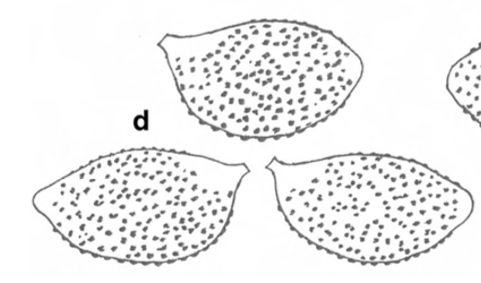Cortinarius brunneoalbus Ammirati, Liimat. & Niskanen
Index Fungorum number: IF551437 Facesoffungi number: FoF00997
syn. C. collinitus var. olympianus A.H. Sm., Lloydia 7(3): 175 (1944)
Etymology: The name refers to the colours of the basidiomata. Holotype: T. Niskanen 09-075 (H). Pileus 30–65 mm, at first hemispherical, then low convex to plane, margin somewhat plicate-striate, ochraceous brown to dull yellowish brown, strongly glutinous, hygrophanous. Lamellae medium spaced, emarginated, at first very pale brown, later pale brown. Stipe 50–100 mm long, 7– 13 mm thick at apex, 8–15 mm at base, cylindrical or very slightly and evenly enlarged downward, white, glutinous. Universal veil glutinous, colourless. Context white to very pale yellow. Odour in the context at the base of the stipe very faintly honey-like. Basidia 4-spored. Basidiospores 13–15(−16)×7.5–8.5(−9) μm (av. = 14.2× 8.5 μm, 40 spores, 2 specimens), Q=1.65–1.8(−1.9) (av. = 1.75), citriform, finely to moderately, densely verrucose, somewhat dextrinoid. Lamellar trama hyphae smooth, somewhat yellow in Melzer’s reagent. Pileipellis. Hyphae in the surface layer 2.5–7 μm wide, hyaline, without clamp connections, embedded in mucus. Hyphae under the surface layer 3–15 μm wide, pigmented, brownish yellow in Melzer’s reagent, somewhat spot-like encrusted. ITS sequence (GenBank KR011128, holotype) distinct from the other known members of the section Defibulati and differs from them it in the ITS region by more than 10 substitutions and indel positions.
Ecology and distribution: In mossy, mesic coniferous forests (Abies, Tsuga). Producing basidiomata in autumn. To date only known from U.S.A., Washington. Material examined: USA, Washington, Clallam, Olympic Hot Springs, Olympic National Park, gregarious under fir, 30 September 1941, leg. A.H. Smith 17437, MICH10337 (MICH, holotype of C. collinitus var. olympianus). GenBank ITS: KR011129. Snohomish County, Barlow Pass, Mount Baker-Snoqualmie national forest, mixed coniferous forest with Tsuga heterophylla and Abies amabilis, 10 October 2009, leg. J.F. Ammirati, K. Liimatainen & T. Niskanen 09- 075, (holotype, H), (isotype, NY).
Notes: In our phylogenetic analysis Cortinarius brunneoalbus is placed in the /Defibulati, a sister group of/ Myxacium. Its placement in the /Defibulati is supported by a combination of morphological characteristics: medium to large basidiomata, glutinous pileus and stipe, large, amygdaloid to citriform spores, and the absence of clamp connections. Cortinarius brunneoalbus is most reminiscent of C. mucifluus Fr., which belongs to the same section and also has a white stipe. Cortinarius mucifluus, however, does not occur in the Pacific North West and has relatively narrower spores (12–16(−17)×7–8.5(−9) μm). Western North American C. vanduzerensis A.H. Sm. & Trappe and C. seidlii Ammirati, Niskanen & Liimat. differ in having a purplish stipe. Sometimes the stipe of C. seidlii is almost white but then it can be distinguished from C. brunneoalbus by its broader spores, Qav. = 1.58.


